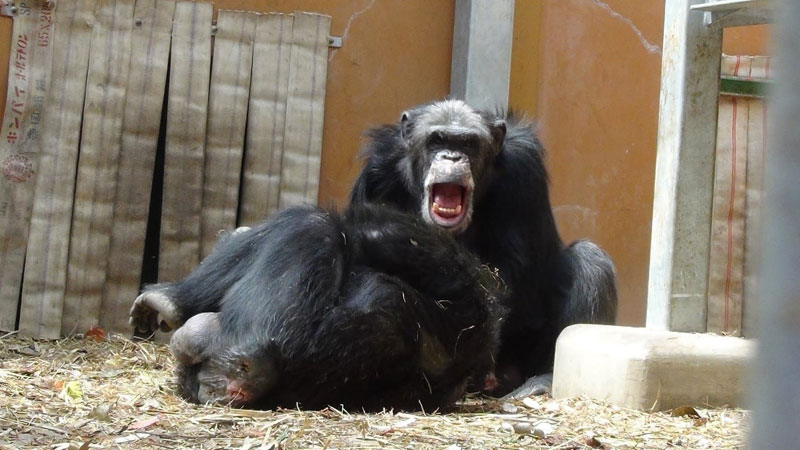飼育チンパンジーのおとな同士の遊びの機能:遊びは福祉の指標になるのか?
Adult-adult social play in captive chimpanzees: is it indicative of positive animal welfare?
Yumi Yamanashi, Etsuko Nogami, Migaku Teramoto, Naruki Morimura, Satoshi Hirata
DOI: 10.1016/j.applanim.2017.10.006Abstract
Play is sometimes considered as an indicator of positive animal welfare. However, it is not yet sufficiently understood whether or not social play among adults can be considered as such an indicator because it is rare in adult animals. This study investigates the factors that influence social play in adult captive chimpanzees in order to discuss its function and use as a welfare indicator. The subjects were 37 adult chimpanzees (17 males and 20 females) living in Kumamoto Sanctuary, Kyoto University, Japan. We completed 367 h of behavioural observation of mixed-sex and all-male groups of chimpanzees between June and July 2014, and December 2014 and March 2015, respectively. We collected data on social play, social grooming (mutual and unilateral grooming), aggressive interactions, self-directed behaviours and abnormal behaviours. We checked the relationship between social play and age, sex, timing, social group formation and different social behaviours. The results reveal that social play increased in males of all-male groups compared to those of mixed-sex groups. Furthermore, we analysed behaviours in individuals from all-male groups and found that social play increased before feeding. In addition, although mutual social grooming showed a negative correlation with aggressive interactions, social play did not show such a relationship. Furthermore, social play and mutual social grooming were negatively correlated. These results suggest that social play may be used as a means to reduce social tension and that it does not necessarily indicate that the individuals formed affiliative social relationships such as mutual social grooming indicates. Therefore, although social play is important to enable the coexistence of multiple adult males who do not always get along well, we need to be cautious when interpreting social play from the view of animal welfare.
背景
哺乳類の多くの動物において遊び行動がみられ,遊びは未成熟個体の社会的・認知的・身体的発達に欠かせない役割を持っていると考えられています。多くの動物種では,未成熟な個体(こども)が遊ぶことが多いのですが,一部の動物種ではおとな同士でも高頻度で遊びが観察されます。わたしたち人間や,わたしたちに近縁なボノボもそういった特殊な動物です。そうしたおとな同士の遊びにどのような機能があるのかについてははっきりわかっていません。また,近年動物福祉科学の研究領域では,遊び行動がポジティブな福祉の指標になると言われています。しかしおとな同士の社会的な遊びにも適用されるのかについては議論が続いています。そこで今回,京都大学野生動物研究センター熊本サンクチュアリのユニークな飼育環境において,飼育チンパンジーの遊び行動を観察し,群れ構成・年齢・社会関係と遊びの関連を検討することで,遊びがどのような機能を持つのか,さらに福祉使用として有効なのかについて議論しました。
研究手法・成果
京都大学野生動物研究センター熊本サンクチュアリで暮らすチンパンジー37個体を対象に合計367時間の行動観察を2014年6月~7月,2014年12月~2015年3月の間におこないました。結果,社会的遊びはオスのみの群れ・夕食前の時間帯といった緊張が高まる状況で増加することがわかりました。さらにオスのみの群において,相互毛づくろいは攻撃交渉と負の相関を示した一方で,社会的遊びは攻撃交渉と相関がなく,相互毛づくろいとは負の相関を示しました。つまり,相互毛づくろいはケンカをあまりしない親和性の高い個体同士でおこなわれていたのに対して,遊び行動はケンカを頻繁にする仲の悪い個体同士でもおこなわれていました。さらに相互毛づくろいを頻繁にするような個体同士には遊びはほとんどみられませんでした。こうしたことから,社会的遊びはおとなの緊張緩和に役立つ可能性が示唆され,限られた飼育環境で複数のオス同士が共存するために重要と考えられました。特に,遊びは仲の悪い個体同士でも可能な社会交渉であることから,必ずしも相性のよくないオス同士の共存には不可欠なのかもしれません。一方で,遊びが緊張緩和と関連している可能性を考えると,動物福祉に関するポジティブな指標として単純に捉えることは難しいとも考えられました。
波及効果
チンパンジーはおとな同士での遊びの頻度は人間やボノボと比べると低いと言われてきました。しかし野生環境と異なり,個体間距離が近くなる飼育下においては,オスの数が多くなると遊び行動の発現が高くなっていました。おとな同士での遊びの進化を考えるうえでも重要な結果と考えられます。また,近年動物福祉への注目が高まる中,動物福祉の客観的な評価をおこなう手法の検討は重要な課題となっています。今回の結果は動物福祉評価に関する議論を深めることに貢献すると考えられます。今後は,内分泌動態などとの関連も調べることなどを通して,遊び行動のメカニズムや機能についてあきらかにしていきます。
